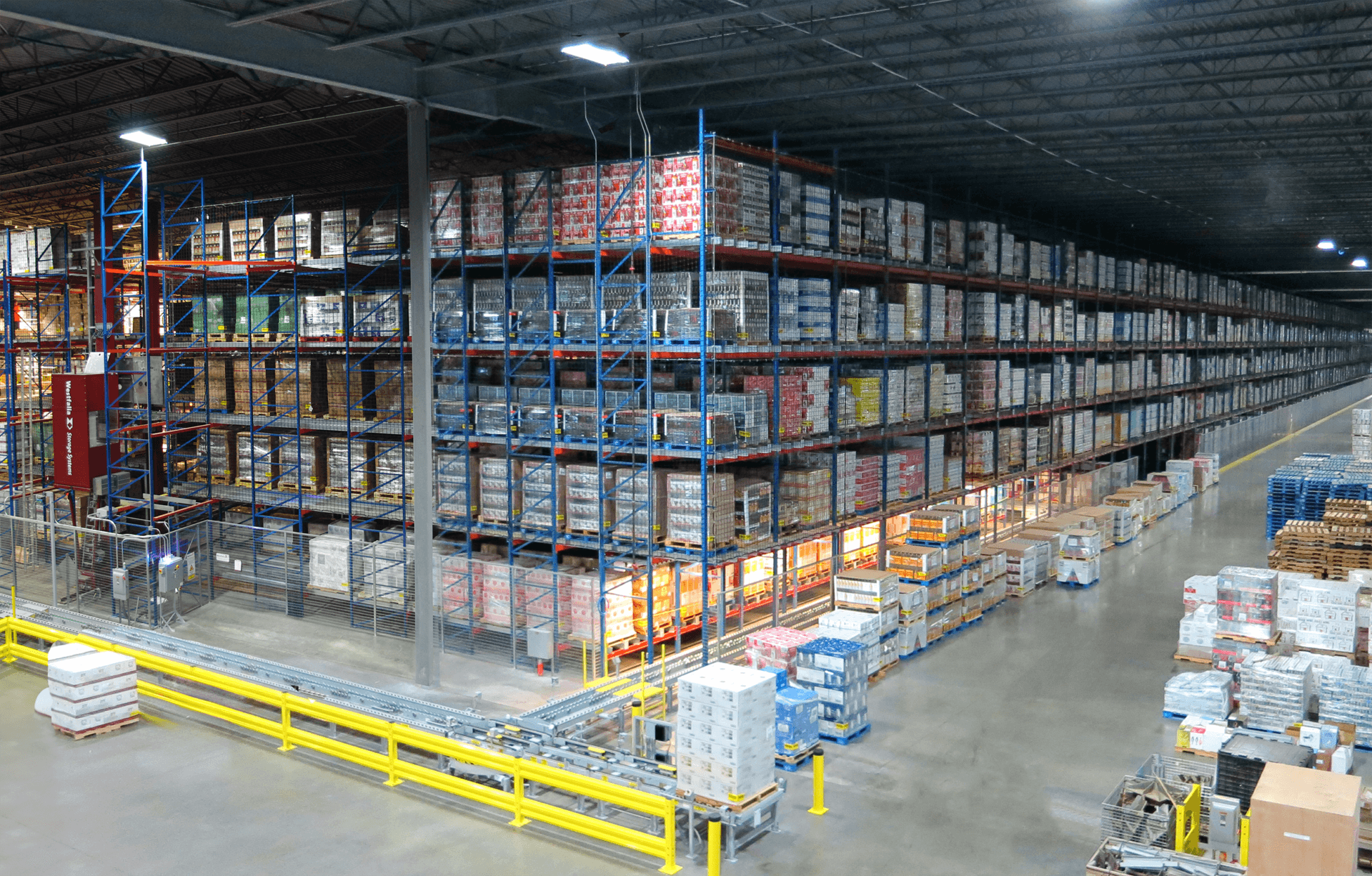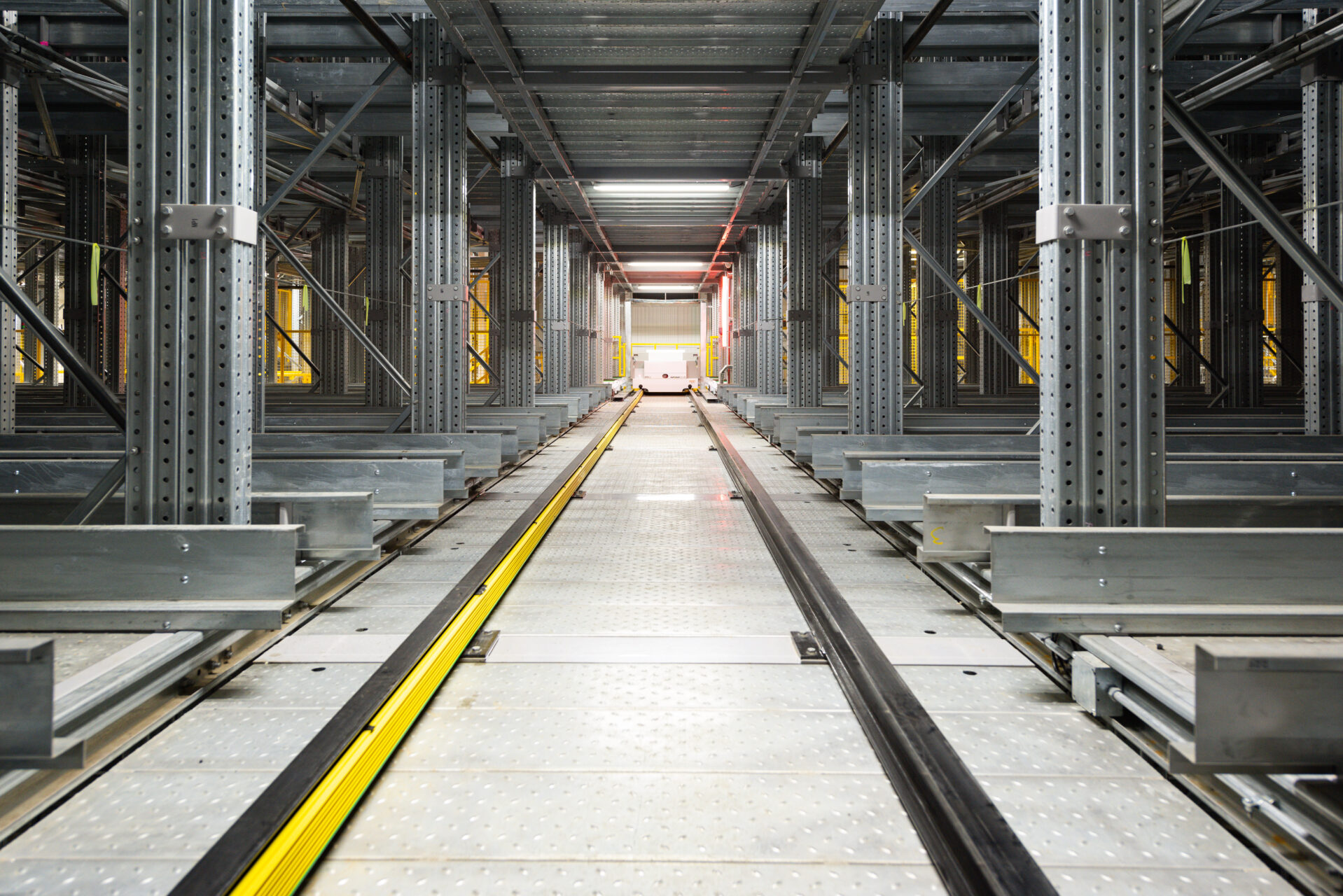Ryan White of AutoMHA, Thomas McLeod of Systems Logistics, and Ryan Smith of Westfalia Technologies contributed to this article.
Increasing demand to store more product, a wider range of product, and perishable product makes finding storage space a daily challenge in today’s climate-controlled facilities. The goal is to maximize space to efficiently and cost effectively retrieve product. Deep lane automation enables more storage capacity and continuous retrieval.
A deep lane AS/RS allows for a high density of pallet storage by placing multiple pallets one behind the other in a single lane, maximizing warehouse space and optimizing storage capacity within a smaller footprint. This design allows the storage of a larger number of pallets in a single deep lane, which requires the use of a rack vehicle to access the items in the lane.
“Deep lane automation allows for more efficient warehouse consolidation by storing multiple pallets deep on either side of the crane aisle, resulting in denser storage,” explains Mark Livesay, vice president of Automated Warehousing at ESI Group. “By reducing the number of storage/retrieval (SR) machines, we can minimize aisle equipment and increase the number of pallet positions available.”

Deep Lane vs. Two-Deep AS/RS
ESI Group works with automation suppliers to determine a climate-controlled facility’s ideal AS/RS. This is often determined by the client’s volume of SKUs being handled, picking frequency, space constraints, and desired level of automation. Livesay says that some clients will request two-deep AS/RS rather than deep lane. He admits that a double or two-deep AS/RS can often optimize both vertical and horizontal space, but the rack can typically hold two pallets compared to the 20-plus pallets that a single deep lane AS/RS can hold.
Ryan White, vice president of Automation Sales, AutoMHA, adds that deep lane AS/RS reduces aisle space, enhances space utilization, and is best suited for high-volume, low-SKU environments, optimizing storage capacity. “Deep lane AS/RS systems are able to maximize the available cubic space with more pallet locations compared to single or double-deep lanes,” agrees Thomas McLeod, area director, System Logistics Technology, System Logistics Corp. “There is not a true mechanical limit to the depth that can be designed, but the data of the facility’s operation (SKU quantity, batch sizes, throughput requirements, available space, etc.) will drive that decision.”
Determining SKU Movement Requirements
Deep lane systems are typically developed with varying depths so that fast-moving and slow-moving SKUs can both be handled adequately without compromising utilization or density. First-In, First-Out (FIFO) requires input on one side of the racks and output on the opposing. Last-In, First-Out (LIFO) means both input and output occur on the same side. LIFO lanes are designed for identical SKU and batch/lot storage. And, First Expired, First Out (FEFO) prioritizes products with the closest expiration date first. In all cases, warehouse order selectors pull the next available pallet at the output.
“It is extremely important to understand the customer’s data — referring to the end customer of the facility where the order is being selected — the demographics of their order selection, and the processes by which unit loads will be retrieved,” says Ryan Smith, vice president of Automation at Westfalia Technologies Inc. “With this understanding, a good “deep lane aware” Warehouse Management System (WMS) can maximize density while maintaining the throughputs necessary to satisfy the shipping needs.”
McLeod agrees that WMS slotting tools and physical design/depth of storage will facilitate FIFO/FEFO/LIFO.
Specific WMS tactics that can be employed to increase pallet accessibility, higher storage usage, and improved FIFO/FEFO/LIFO management. These include:
• Keep high moving SKUs stored in deep lanes near the infeeds and outfeeds of the system;
• Mix lowest moving SKUs in storage lanes at the end of the aisle; and
• Balance SKU management between these two extremes. Livesay adds that a good WMS and Advanced Shipping Notice work together to ensure that a pallet needed the next day can be either re-warehoused or make certain no other pallets are placed in that lane until it is relocated.

Realizing Cost Savings
Depending on the number of SKUs, inventory turnover, and the batch/expiration date quantities for each product, automation suppliers expect a deep lane AS/RS to achieve 90% rack utilization. They also point to specific cost savings that can be realized using deep lane automation:
Time & Labor: A deep lane AS/RS automates pallet movement, improves retrieval efficiency, reduces reliance on forklifts, and minimizes manual labor for pallet handling, leading to faster throughput and reduced labor costs.
Cooling Costs: In climate-controlled environments, deep lane storage condenses inventory into a smaller footprint, lowering refrigeration requirements and energy costs.
“Vestibules greatly reduce the energy costs of a building, and deep lane storage also reduces the number of vestibules needed to accomplish that same task,” says Smith.
Space Utilization: Deep lane automation eliminates excess aisle space, enabling more pallets to be stored per square foot and reducing the need for facility expansion. White says that maximizing storage density within a smaller facility footprint reduces real estate and operational expenses.
“Space savings directly correlate to less cost for construction, cooling, etc., and provide more flexibility for future growth of throughput compared to a fixed maximum capacity of pallets in, and pallets out, in a single or double-deep configuration using a crane-based AS/RS,” says McLeod.
Productivity: Continuous, fully automated operations reduce downtime and increase throughput, all while maintaining inventory accuracy.
Smith says: “The design advantages of a deep lane AS/RS and the associated cost savings permeate throughout the entire facility to accomplish successful order selection.”
Quick Facts
- 49% of packaging/processing executives cite automation as a top priority in 2025.
- The global industrial automation market could reach $406.23Bn by 2031.
- Process automation can reduce operational costs by up to 30%.
Contributing Authors

Join our eNewsletter
Get industry trends and insights for climate-controlled facility design and construction quarterly.
